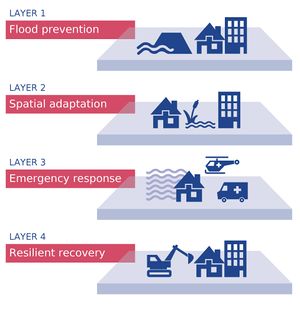LC 00275: verschil tussen versies
Geen bewerkingssamenvatting |
Geen bewerkingssamenvatting |
||
| (10 tussenliggende versies door dezelfde gebruiker niet weergegeven) | |||
| Regel 1: | Regel 1: | ||
[[Bestand:Layer4 geentekst.jpg|gecentreerd|kaderloos|500x500px]] | |||
==== What is layer 4? ==== | |||
The fourth layer of the Multi-Layered safety concept refers to resilient recovery after a flood event. Flood recovery is usually managed separately from flood risk mitigation and focuses on immediate effects of a flood and short-term actions for recovery. However, FRAMES recognises that ‘adaptive recovery’ gives the opportunity to reduce the impact of a future event on society in the long term. | |||
===== Layer 4 in the MLS concept ===== | |||
By using the Multilayered Safety (MLS) concept, different types of flood management measures are integrated, resulting in an overall reduction of the probability and the consequences of floods. MLS consists of four layers. Prevention is the first layer of MLS. The second and third layers are consequence-reducing measures, namely spatial solutions (layer 2) and emergency response (layer 3). Layer 1 and layer 2 are physical measures, whereas the third and fourth layers, crisis management and recovery, concentrates on organizational measures.Together, these layers can be tailored to local areas in order to minimize flood damage. | |||
[[Bestand:4layer illustratie totaal.jpg|gecentreerd|kaderloos]] | |||
==== What measures were taken in the FRAMES pilot in this layer? ==== | |||
The FRAMES pilot working with measures in layer 4 focused on {{Internal link|link=LC 00303|name=learning from previous recovery processes|dialog=process-linkpage-dialog}} to improve recovery capacity in case of future flooding. | |||
==== What tools were used in the FRAMES pilot in this layer? ==== | |||
FRAMES has compiled a list of tools used in the pilots and classified these per layer. Click {{Internal link|link=LC 00226|name=here|dialog=process-linkpage-dialog}} to find out what tools are available for layer 4. | |||
{{Light Context | {{Light Context | ||
| Regel 10: | Regel 19: | ||
|Supercontext=PR 00274 | |Supercontext=PR 00274 | ||
|Topcontext=PR 00069 | |Topcontext=PR 00069 | ||
|Heading= | |Heading=Layer 4: Resilient recovery | ||
}} | }} | ||
Huidige versie van 8 jul 2020 om 15:27
What is layer 4?
The fourth layer of the Multi-Layered safety concept refers to resilient recovery after a flood event. Flood recovery is usually managed separately from flood risk mitigation and focuses on immediate effects of a flood and short-term actions for recovery. However, FRAMES recognises that ‘adaptive recovery’ gives the opportunity to reduce the impact of a future event on society in the long term.
Layer 4 in the MLS concept
By using the Multilayered Safety (MLS) concept, different types of flood management measures are integrated, resulting in an overall reduction of the probability and the consequences of floods. MLS consists of four layers. Prevention is the first layer of MLS. The second and third layers are consequence-reducing measures, namely spatial solutions (layer 2) and emergency response (layer 3). Layer 1 and layer 2 are physical measures, whereas the third and fourth layers, crisis management and recovery, concentrates on organizational measures.Together, these layers can be tailored to local areas in order to minimize flood damage.
What measures were taken in the FRAMES pilot in this layer?
The FRAMES pilot working with measures in layer 4 focused on learning from previous recovery processes to improve recovery capacity in case of future flooding.
What tools were used in the FRAMES pilot in this layer?
FRAMES has compiled a list of tools used in the pilots and classified these per layer. Click here to find out what tools are available for layer 4.
Hier wordt aan gewerkt of naar verwezen door: Community resilience, Critical infrastructure, Flood proof design and planning, Layer 4- Resilient recovery, Natural flood management, Preparedness and emergency planning, Recovery learning


